How to Meal Plan the Easy Way (20 Minutes or Less)
I grew up in a family of seven—five siblings and my mom and dad. My mom was a master at creating meals out of anything that she had available. But, I never saw her create a structured meal plan. She had “a grocery list” and she knew what money she had to spend. Whenever she could, she used coupons. Mostly, she just figured things out as she went. And while my mom was a master at how to meal plan, when I became an adult, I had no idea how to create a meal plan, a menu, or create a meal plan on a budget—the right way.
And if you’re anything like me, you don’t have time to sift through an expert guide on meal planning—even if it is from Taste of Home. You want to know how to meal plan the easy way—and I want to help you do just that. So let’s get rid of EVERYTHING you need to have to meal plan and dial things back to make this process simple, effective, and what will work for you.

Meal Plan or Pay Off Debt?
Right now there is a lot of concern about food shortages and inflation for buying groceries. Likely, that might be why you’re really trying to figure out how to meal plan in the first place. This actually brings up an important question: is your goal to meal plan or is it to save money? You can do both, and I’ll share how in a bit. But the reality is that having a clear perspective of what your main goal is, will really help you to create a meal plan that works for you.
Honestly, what a lot of people are going through right now, isn’t much different from when I started to consider meal planning years ago. My biggest struggle in how to meal plan came after I graduated from college and the bills starting to pile up.
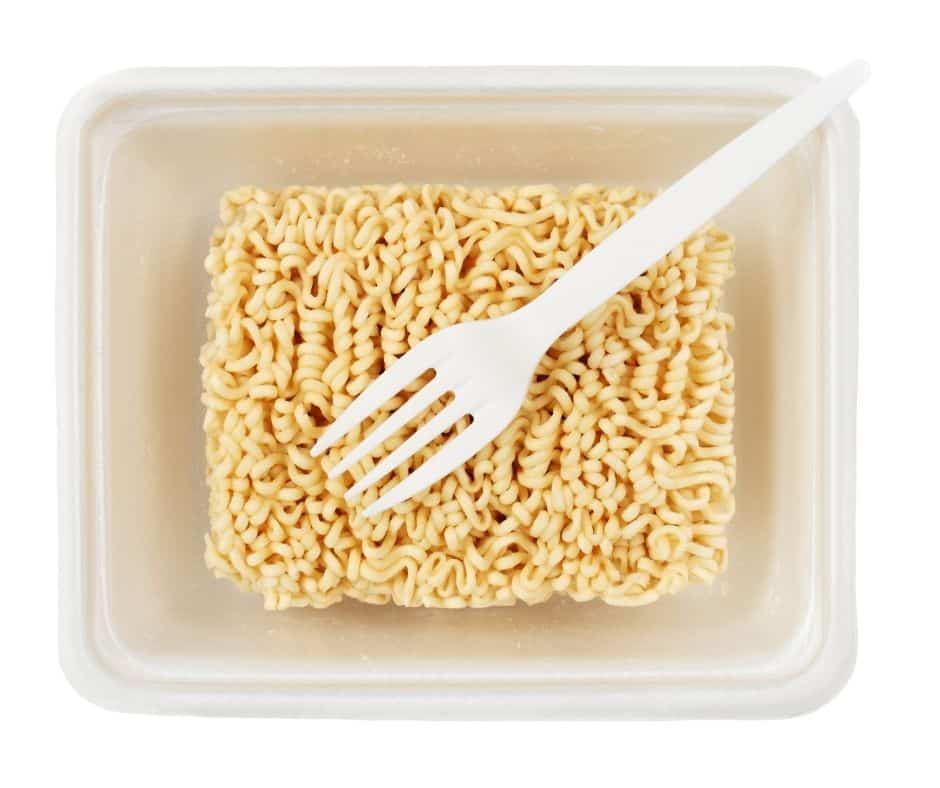
At the time, I had convinced myself that my bills were more important than what I ate. I figured, that I didn’t need to plan meals, I could get by with just eating ramen noodles, boxed mac n cheese, and maybe some baked chicken every now and then. Even though I had knowledge about what it meant to live a healthy lifestyle as a Christian, and my mom definitely had a plan for feeding us as kids, my main goal was to get rid of my debt as fast as I could.
I was laser focused on making that happen—so that’s what I did.
Once I became more financially established in my career, I got into a rhythm for deciding what I would I would eat for the week and what I would buy for groceries. But I still didn’t really create a meal plan or a menu. I just bought what I wanted to and when I wanted it. Often I think that’s because I was single and I wasn’t really responsible for anyone else.
Then, I got married.
And the questions started!
My husband was always like, “What’s for dinner, sweetheart?”
“Umm….this!” I would say.
It ended up being whatever I had available in the cupboards and the refrigerator that was easy to whip up for the night. (That part I did learn from my mom—to use everything and anything that I had on hand so that I didn’t waste anything.)
Sound familiar?
You don’t have a meal plan, so you end up scouring through what you do have hoping that there’s a least one thing that could pass as being healthy and that there’s at least two things that will go together for a meal. Likewise, if it isn’t your husband, it’s your kids asking that infamous question, “What’s for dinner?”
Interestingly enough, my mom actually had a recipe called “What’s for Dinner.” I’ve never used it, but it is a funny take on the on–going saga of the reality of figuring out how to meal plan for a family. You have to figure out for the rest of your life what you’re going to feed your family for breakfast, lunch, dinner. And of course, my husband always says, “Don’t forget dessert!”
How to Create a Meal Plan the Easy Way
Have you ever counted how many meals it takes to feed your family for a year? I have and it’s roughly 1,092 meals a year (give or take a few if you go out to eat as a family, if your kids go to school, or either you or your husband eats out for lunch or dinner). The good news is that you don’t have to plan all those meals at once, right?!! That’s a lot of meals and most often you’re not prepared to do that well—unless someone teaches you or you figure it out for yourself.
Like I mentioned before, I grew up learning how to cook and bake, but I never really learned from my mom how to create a meal plan, how to plan a menu for a week, let alone plan a menu for a month or even for a family. Although my mom did do all of these things to save time and money.
I did ask her one time how she did it all those years—keep us all fed and still afford it. Honestly, she didn’t really have a plan to teach me, at least that she could clearly articulate.
So for years, I tried to figure things out for myself. I went through a process of learning what has worked for others then trying to determine what works for me and my family. And I gotta tell you, after nearly ten years, I’ve finally come up with the easiest way for how to meal plan. In fact, it’s been so easy that when I sit down to do it, I’ve been able to create a meal plan for anywhere from two weeks at a time to up to a month in as little as 20 minutes.
The first thing that you and I have in common is that we have a history of what we tend to make for our families. Now, what I make and what you make or have made is likely different, but this same process will still work for you.

Here’s my 3 Step Process:
- Write down Main Dishes for meals on a 3 x 5 card.
- Organize the Main Dishes by category.
- Create your meal plan.
Also, you don’t need any fancy supplies. This is what I use:
- a pen
- some 3 x 5 cards
- some 3 x 5 card dividers
- a 3 x 5 card box or folder
- a Weekly Meal Plan Template laminated card or a menu dry erase board
- Wet erase markers
Most people suggest dry erase markers, but I will always recommend the wet erase markers instead. They tend to be twice the price of dry erase markers. But it’s so worth it—because the wet erase markers don’t smear and they don’t leave marks on your laminated card or dry erase board.
If this 3 Step—How to Meal Plan Process seems simple, that’s because it is. And that’s why this process works for me. I don’t have to hold onto weeks of written meal plans or recipes and then rotate them, although you might find that helpful. I’ve done that before, but with this simple process, I can create a meal plan by just starting with the Main Dish. It has been so much easier for me. Plus, I can mix the plan up based on what we’re craving, what’s on sale, while I’m accounting for any special occasions on the calendar.
So let’s get to the details of how to actually create your meal plan process.
Step 1: Write Down Your Main Dishes
The first thing that you’ll do, is write down on individual 3 x 5 cards all of the main dishes that you tend to make. When you first do this, it might take a few minutes to remember. Don’t stress too much about it. Just work to add things to your cards when you remember—but try to have at least 10 cards to start.
I’m still adding things to cards all the time.
The reason that I only write down the Main Dish is because typically this is what we think of when we think of a meal—then you can mix it up what you have for side dishes. It’s much easier to just start with a main dish first because you don’t have to figure out the whole meal. It really simplifies things to simplest step.
Keep in mind that writing things down on cards isn’t meant to be anything “fancy” for Instagram or remotely close to being Pinterest worthy. You’re simply putting together a system that’ll work for you. But…if making things pretty is your thing, then go for it!
Here’s what my Main Dish cards look like. It’s really simple. I don’t even write the recipe down. But for quick reference, from time to time I may write down where the recipe is at—like a favorite cookbook, Pinterest, or somewhere else.
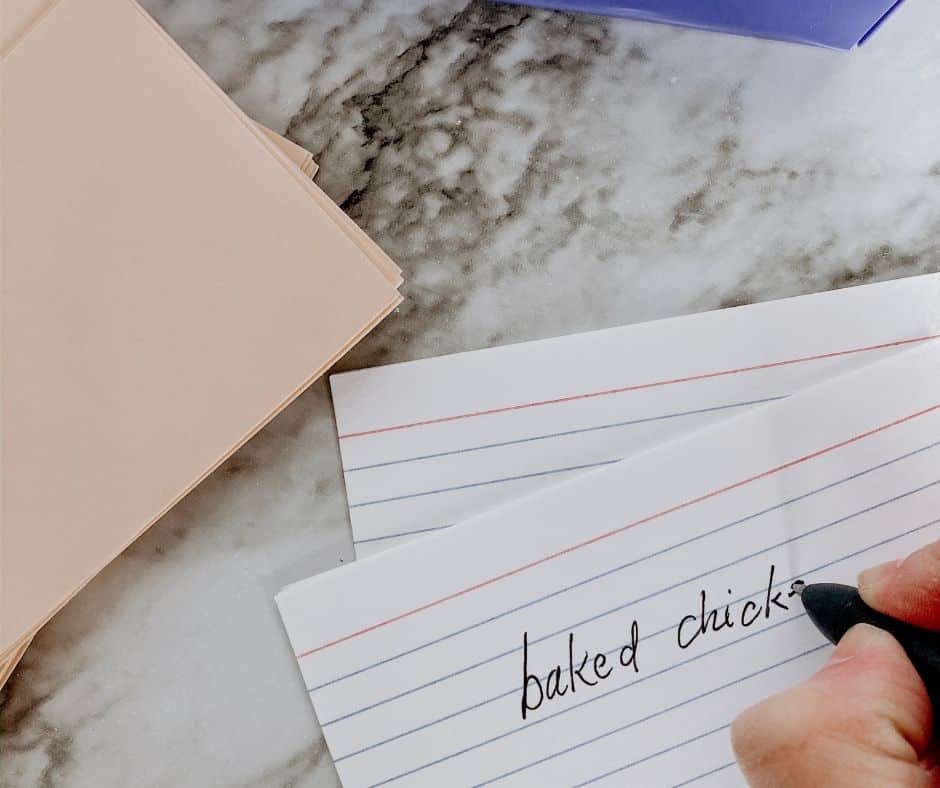
Step 2: Organize Your Main Dishes By Category
After writing down all of your main dishes, then start to organize them by category. For me, I have them separated out into several different types of categories:
- Beef
- Pork
- Chicken
- Crockpot
- Breakfast
- Fish
- Sandwiches
- Special Dinners
- Pasta / Italian
- Salads
- Soups
Basically, you want to create categories that make sense to you. Maybe there’s even a lunch, brunch, or breakfast category.
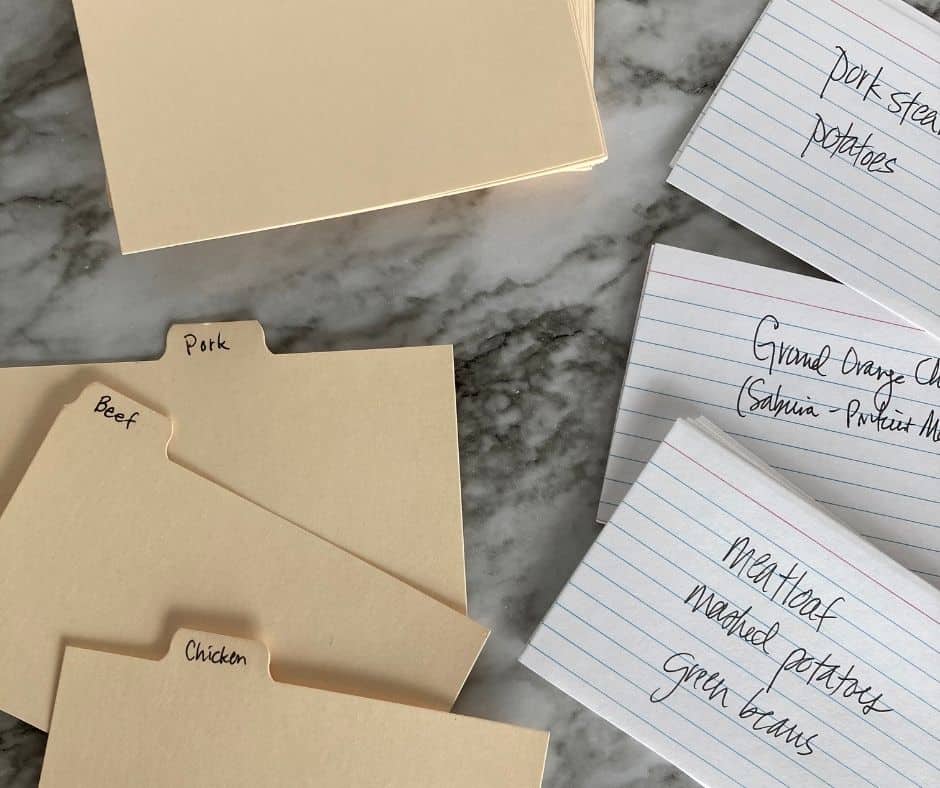
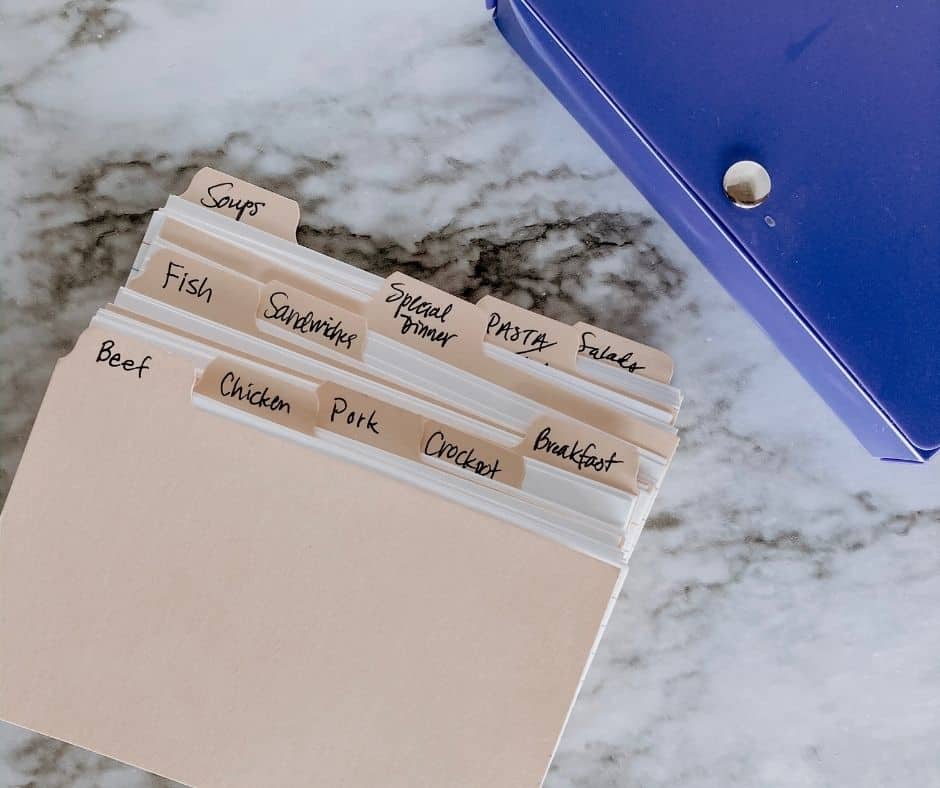
Step 3: Create Your Meal Plan
Next, start to fill your choices on either a Meal Plan Template that is a laminated card (I actually made one for myself). Or you could use a meal plan dry erase board for the week or month. I’d recommend this dry erase board from Ubrands. I originally bought this specific dry erase board before from Wal-mart and it doesn’t take up much space on the side of the refrigerator.
How do I go about creating a meal plan? There’s actually two ways to do this—the quick way and the strategic way.
THE QUICK WAY TO CREATE YOUR MEAL PLAN
First, if you want to just start to get a plan together, just pull out your main dish cards and select something for at least 5 nights out of your 7 days of your week. Write them down on your Weekly Meal Plan Template laminated Card for Dinner. For the two remaining dinners, plan to have leftovers for the night. (You can forego this if you use leftovers for lunches. I’ll talk more about this in a bit and how it relates to how you specifically meal plan).
I don’t write down my “main dish” for lunches and breakfasts in this process, but you can do that and separate it out for a category. Instead, I just have a list of ideas set aside that I just pick from and write those down. I actually included them on my Weekly Meal Plan Template laminated card. For me, it’s all about figuring out the Dinners first, then once I have dinners figured out, it’s easier to fill in the lunches and breakfast options.

THE STRATEGIC WAY TO CREATE A MEAL PLAN
The second way that you can create a meal plan is to take into account some other specific factors like a budget, nutrition, and what would help you save time as a wife and mom. This takes a little more thought, so I don’t recommend doing this until you’ve simply created at least a habit of creating a meal plan for a month. If you’re interested in this a little more, read more about it in 9 Different Meal Planning Ideas to Make Dinner Fast, Inexepensive, and Inexpensive.
The key reason that this method is so easy for learning how to meal plan, is that I’m simply helping you to put a process in place for what you already do! I’m not suggesting any different “meals” or specific “lists”. My process is just helping you to remove a lot of pressure by putting together a plan that focuses on just one detail to start—Main Dishes—then you add in the rest of the details. This all helps you to begin to experience some pretty big benefits, successfully and in a short amount of time. And that’s what I really want for you—to be successful and experience a quick win for you and your family.
With all of this comes some pretty exciting benefits.
One of the biggest benefits of meal planning is that instead of just “winging it”, you’re planning in advance what things look like for the week, bi–weekly, or for a monthly meal plan. It’s out of your head and onto paper—so everyone knows “What’s for dinner!”. From a biblical perspective, this is something that God wants us to do, and a big reason why it’s number 4 in the Christian Mom’s Secret to Being a Great Parent.
A second benefit is that because you have a meal plan in place, you tend to only buy groceries for what you need, not what you want. It ends up helping you to stick to that budget.

How to Meal Plan So It Works for You
Now you might be thinking, this is all good on paper, but will this really work for me? The first answer is yes.
The truth is—you already have everything that you need to successfully create a meal plan effortlessly. You’ve already been following a plan—you just need to get that plan on paper to help you plan ahead and give your family a sense of direction in the process.
Here are some more tips to help you know how to meal plan—so that it works for you.
Tip 1: Consider what you “typically do” or what will be natural for you to do—like Tacos for Tuesday or Meatless Mondays. Some families always have Friday nights as Pizza Night. One thing that I used to do pretty regularly is that I would always plan Mondays as the night I would fix chicken. This also removed the pressure to choose something. It narrowed down my choices for me.
Tip 2: Plan at least 1 Favorite Night or a Family Night. This would be something that you can do to continue or create new traditions. Right now, we are doing “Family Night” every Wednesday. It means that I plan the meal with a focus on creating more relational connections for our family together. It’s different what we do, but the goal is to connect us as a family.
We’ve also done a “Favorite Night” where I specifically make someone’s favorite meal. This could also be an opportunity to help you include your kids—and husband—in the process of selecting what’s on the meal plan. Your kids could even help shop for the groceries, giving them a real world experience and helping them to know how to do it for the future. This too is all a part of having a plan for your family that helps them feel like they matter.
That’s another thing that my husband loves about me having a meal plan already established for the week. He has something to look forward to and he knows what’s for dinner. I know it may seem simple, but for my husband, it makes him feel at ease to know what is for dinner and that I’m considering his favorites too!
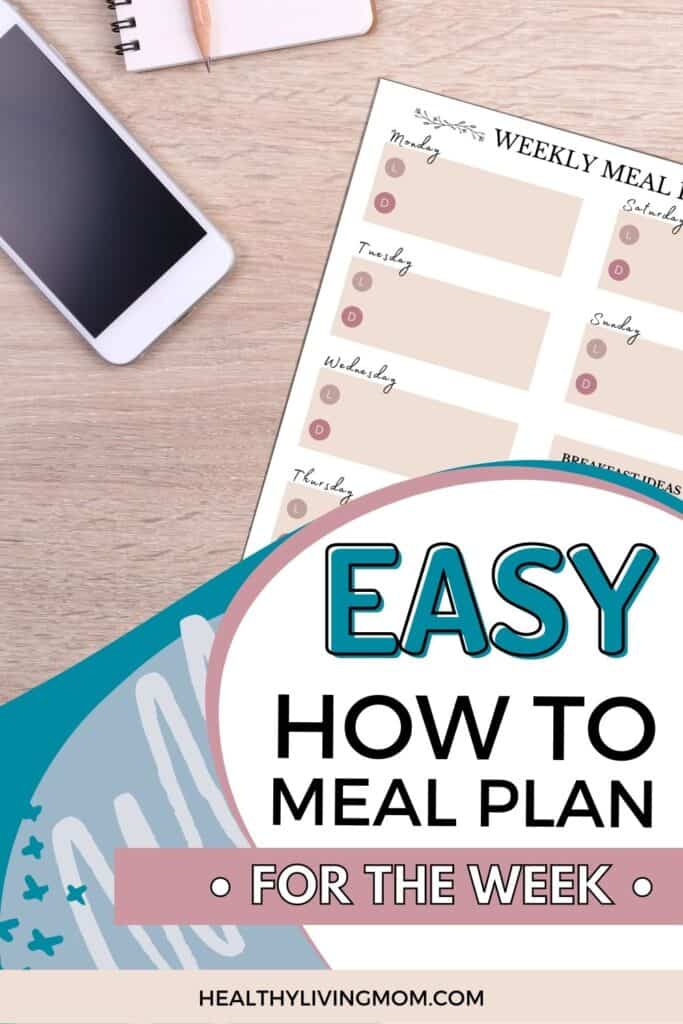
Advice: Before You Start to Meal Plan
The thing I love about my mom is that even though I didn’t learn this process directly from her—she showed me that it’s possible to do it. And, who knows, maybe her way of doing things would’ve never worked for me anyway. You see, she had her own way of creating a meal plan for our family of seven. And what she did worked for her. Likewise, what I’m sharing with you today is what works for me and I hope that it helps you.
And that leads me to the second answer to your question, “Will this really work for me?”
Honestly, there’s no way to guarantee that the way that I meal plan, will actually work for you. But, if it doesn’t, don’t get discouraged! Keep trying to figure out what works for you. In fact, this is the most important thing that I encourage others to do first when they are starting to meal plan as a beginner.
You see, what I’ve learned over the years is that the biggest hurdle for us is that we end up making it harder than what it really can be. We get stuck on trying to make up a meal plan that follows exactly what someone else has done. And while this can help, in my experience, it doesn’t always work.
Why? Because you may have different goals than that person.
Maybe you want to have variety? Just eating the same thing over and over again—that gets boring for everyone! And it’s not exactly healthy either because you’re not getting a full spectrum of nutritional value from what you’re eating. If you’re anything like me, you likely have goals for your meal plan that might include making healthy choices—like a low sodium diet. Or maybe you want to keep an eye on how much your spending so you can stick to a budget.
Creating a meal plan based on someone else’s grocery lists and someone else’s pre–written meal plans simply won’t work. But when you look at how you do things, what strategy and style fits you and your family’s personalities and nutritional needs then making a meal plan specifically for your week will definitely help you to achieve these goals a lot easier.
So, if there’s anything that I want you take away from me sharing my process for creating a meal plan, it’s this: try it, and if it doesn’t work, keep figuring out what will work for you. And I’d also encourage you with one more thing that I want you to know. Unlike what I did in my early adult years, you don’t have to sacrifice eating healthy in order to save money. You can eat healthy and buy groceries on a budget. I’ll be talking more about that in a future post.






